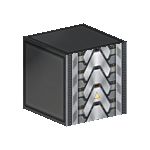Difference between revisions of "Rail Basic"
(added header, item description and navigator) |
(Added basic usage information.) |
||
| Line 7: | Line 7: | ||
{{production/Rail_Basic}} | {{production/Rail_Basic}} | ||
==Usage== | ==Usage== | ||
| − | + | A [[Rail Docker]] can be attached to a Rail Basic using the Rail Dockers docking beam on the rail you wish to dock to. | |
| + | The arrows on the rail and docker indicate which way the docked entities will allign. | ||
| + | |||
| + | A Rail Basic will try to move a docked Rail Docker onto another rail in the direction the arrows on its face are pointing. If there is no rail in that direction, the docker will do nothing. | ||
| + | |||
| + | ===Logic Functions=== | ||
| + | If an [[Activation Module]] is placed next to a rail, it will output a high signal when a docker is attached or moving over that section of the rail. | ||
| + | |||
| + | It is also possible to change the orientation of a rail block or replace it with a different type of rail block. To do this, place an Activation Module next to the rail block you want to act as a source. Then add a logic connection from the Activation Module to all rail blocks you want to be replaced by the source block. When the Activation Module receives a high signal, it will copy the type and orientation of the source block to all rails the Activation Module is connected to. Note that this method can not modify [[Rail Turret Axis]]. | ||
| + | |||
| + | Both of these functions also work with [[Button|buttons]] instead of Activation Modules. | ||
==Related== | ==Related== | ||
{{Docking Navigator}} | {{Docking Navigator}} | ||
[[Category:Docking]] [[Category:General]] | [[Category:Docking]] [[Category:General]] | ||
Revision as of 20:52, 4 November 2017
| This page is currently a stub. Please help us out by expanding it. |
| Rail Basic | |
|---|---|
 | |
| Hit Points | 100 |
| Reactor Hit Points | 0 |
| Mass | 0.05 |
| Luminosity | none |
| Data Value (ID) | 662 |
Rail Basics are the primary docking module for use in rail docking systems. While alone they act as stationary docks but if placed adjacent to one another they will automatically move docked entities around.
Item Description
"This is the basic rail module. As a single bock this module works like a docking module. You can put more of them together to make a track. Use the 'Rail Docker' to dock to this block."
Production
| Production Info | |||||
|---|---|---|---|---|---|
| Produced in a | Standard Factory |  |
|||
| Requires | To create | ||||
| Sintyr Capsule | x10 |
 |
Rail Basic | x1 |
 |
Usage
A Rail Docker can be attached to a Rail Basic using the Rail Dockers docking beam on the rail you wish to dock to. The arrows on the rail and docker indicate which way the docked entities will allign.
A Rail Basic will try to move a docked Rail Docker onto another rail in the direction the arrows on its face are pointing. If there is no rail in that direction, the docker will do nothing.
Logic Functions
If an Activation Module is placed next to a rail, it will output a high signal when a docker is attached or moving over that section of the rail.
It is also possible to change the orientation of a rail block or replace it with a different type of rail block. To do this, place an Activation Module next to the rail block you want to act as a source. Then add a logic connection from the Activation Module to all rail blocks you want to be replaced by the source block. When the Activation Module receives a high signal, it will copy the type and orientation of the source block to all rails the Activation Module is connected to. Note that this method can not modify Rail Turret Axis.
Both of these functions also work with buttons instead of Activation Modules.